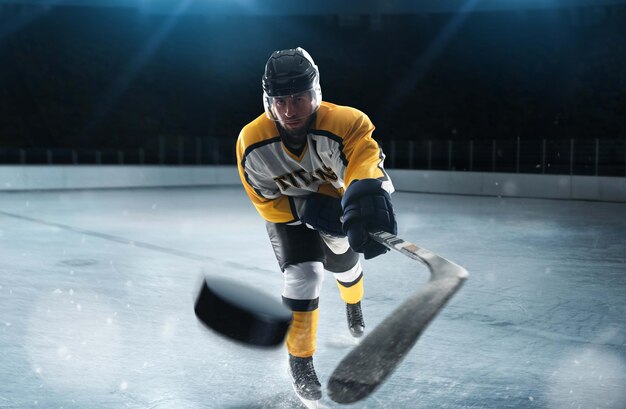
Few moments in hockey are as electrifying as a well-executed slapshot. Whether it’s the sound of the puck hitting the stick, the sight of it rocketing across the ice, or the anticipation of it striking the back of the net, slapshots have long been a defining feature of the game. But beyond the surface excitement lies a fascinating interplay of physics, biomechanics, and technique that makes this shot so powerful.
At its core, the slapshot is a blend of kinetic energy, speed, and precision. Players generate an incredible amount of force in a matter of milliseconds, transferring their body’s motion into the stick and ultimately the puck. This movement involves multiple scientific principles, including energy transfer, momentum, and friction, each of which plays a critical role
Understanding the Mechanics of a Slapshot
The slapshot is one of the most iconic and powerful shots in hockey, characterized by its explosive release and impressive velocity. At its core, the mechanics of a slapshot involve a combination of body movements, stick positioning, and the physics of energy transfer. When executed properly, a slapshot can reach speeds exceeding 100 miles per hour, making it a crucial skill for any hockey player aiming to score.
To grasp the mechanics of a slapshot, it is essential to break down the process into several key components:
Key Components of a Slapshot
- Stance and Grip: A proper stance involves placing the feet shoulder-width apart for balance. The grip on the stick should be firm but not overly tight, allowing for flexibility during the shot.
- Wind-Up: The wind-up is crucial for generating power. Players pull the stick back, creating potential energy that will be released during the shot.
- Weight Transfer: As the player prepares to shoot, they shift their weight from the back foot to the front foot. This transfer of weight helps to add force to the shot.
- Follow-Through: The follow-through is just as important as the wind-up. A strong follow-through ensures that the energy generated during the shot is maximized, contributing to the puck’s velocity.
By mastering these components, players can significantly improve their slapshot technique, allowing them to unleash powerful shots on goal. Understanding the mechanics not only enhances performance but also reduces the risk of injury by promoting proper body mechanics.
The Science of Slapshots: Physics Behind Hockey’s Most Powerful Shot
The slapshot is one of the most exhilarating and powerful techniques in hockey, captivating fans with its sheer speed and precision. Understanding the physics behind this remarkable shot reveals the key principles that athletes exploit to achieve maximum performance on the ice. By examining the fundamental forces at play, we can appreciate the complexity and skill involved in executing a perfect slapshot.
Several key physical principles govern the speed and accuracy of a slapshot. These principles not only determine how effectively a player can strike the puck but also how the puck interacts with the ice and air as it travels toward the goal. The following sections will explore the essential concepts of momentum, force, and angle in the context of slapshots.
Key Physical Principles Governing Slapshot Speed and Accuracy
- Momentum: The momentum of a puck is defined as the product of its mass and velocity. A player can increase the momentum by generating greater speed in their swing. The greater the momentum transferred to the puck, the faster it will travel toward the net.
- Force: The force applied during the slapshot plays a crucial role in determining the speed. The formula for force is F = ma (Force = mass × acceleration). Players increase force by accelerating their stick through the puck, maximizing the energy transfer.
- Angle of Impact: The angle at which the puck is struck significantly affects its trajectory. A lower angle can lead to a more direct shot, while a higher angle may create a more arcing path. Players must consider the optimal angle to achieve both speed and accuracy.
In summary, the physics of a slapshot involves a combination of momentum, force, and angle. By mastering these principles, players can enhance their shooting techniques, resulting in faster, more accurate shots that can significantly impact the game.
The Impact of Equipment and Technique on Slapshot Performance
The effectiveness of a slapshot in hockey is significantly influenced by both the equipment used and the technique employed by the player. Advances in technology have led to the development of specialized sticks, skates, and protective gear, all designed to enhance performance and minimize injury. These innovations allow players to maximize their shot power while maintaining accuracy and control on the ice.
Moreover, the player’s technique plays a crucial role in executing a powerful slapshot. Proper body mechanics, foot placement, and follow-through are essential for generating the maximum amount of force. As players master these techniques, they can better harness the kinetic energy generated from their movements, resulting in more powerful and effective shots.
Key Factors Influencing Slapshot Performance
- Stick Technology: Modern sticks made from composite materials offer increased stiffness and reduced weight, contributing to higher shot velocity.
- Blade Design: The curvature and material of the blade can affect puck control and shot accuracy.
- Shooting Technique: Proper weight transfer and body positioning are critical for maximizing shot power.
- Player Training: Regular practice and training focused on slapshot mechanics can significantly improve a player’s shot performance.
In conclusion, both equipment and technique are vital components that determine the effectiveness of a slapshot in hockey. As players continue to refine their skills and utilize advanced technology, the power and precision of slapshots are expected to evolve, pushing the boundaries of what’s possible on the ice.

